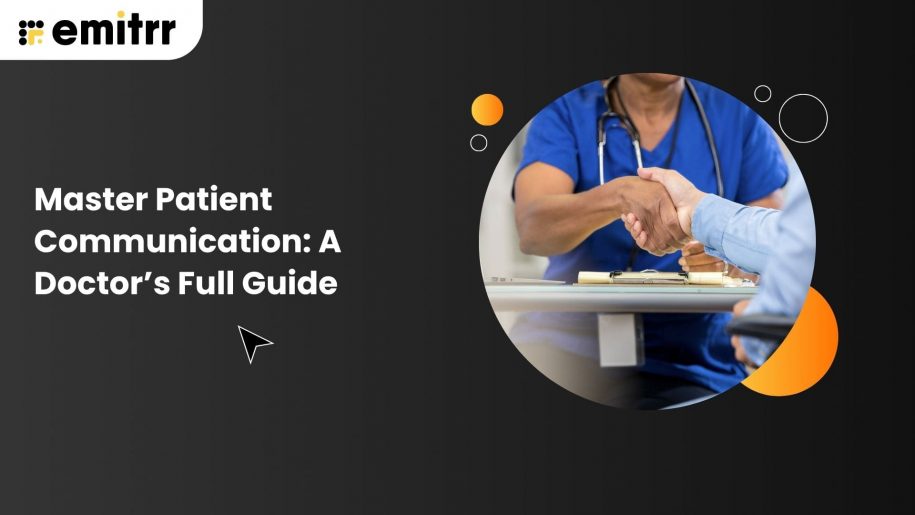Introduction to Patient Communication
Effective patient communication is the key to delivering quality care, establishing a strong therapeutic relationship, and ensuring positive health outcomes. To be able to provide effective care, you, as a healthcare provider, must direct your focus towards communicating effectively with your patients. This article will walk you through the nitty-gritty of communicating with patients, including the benefits, risks, channels, and best practices. Stay tuned!

What is Patient Communication?
Patient communication refers to information and the way the information is exchanged between the healthcare provider and the patient. It includes various kinds of interaction, including verbal, non-verbal, digital patient engagement, active listening, and understanding what the patient is trying to convey. Communication with patients should always be HIPAA-compliant when done digitally via SMS, email, or phone, and should always protect their sensitive information.
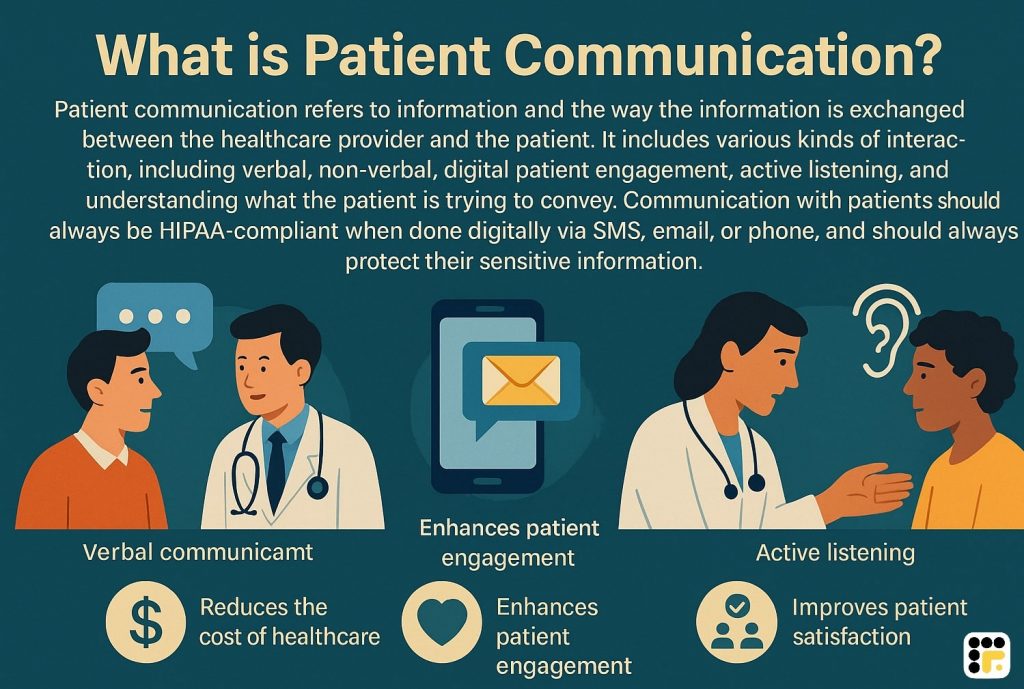
Any verbal or non-verbal interaction between the healthcare provider and patient reduces the cost of healthcare, enhances patient engagement, improves patient satisfaction, and builds a patient-centered healthcare environment.
Why is Effective Patient Communication with Patients Important?
Effective communication with patients is important for some key reasons:
- Accurate diagnosis & treatment: Miscommunication with patients can lead to errors in diagnosis or treatment, which can be detrimental to your healthcare reputation. Effective patient communication ensures that the patient understands everything correctly.
- Builds rapport & trust: When patients feel heard and understood, they find it easy to trust their healthcare provider. This patient trust helps them in sharing sensitive information more openly, leading to better diagnosis and treatment, which, in turn, helps you in building good patient rapport.
- Improves patient satisfaction: Patients want to feel valued, heard, and respected. Good communication with patients helps them feel supported and thereby helps in improving patient satisfaction.
- Improves team collaboration: Healthcare is not just about communicating with patients; team communication and collaboration are equally important. When you strengthen communication with your team, including nurses, doctors, pharmacists, insurance companies, etc., you can get the best results.
- Lower dropout or no-show rates: Even proactive communication that’s done digitally, such as sending reminders, follow-ups, etc., helps in reducing patient no-show and dropout rates.
In short, all aspects of effective communication with patients, be it digital interaction, face-to-face interaction, or internal interaction- all should be in line and taken care of to get the best results.

Examples of Effective Communication in Healthcare
Let’s take a look at a few examples of effective communication in healthcare:
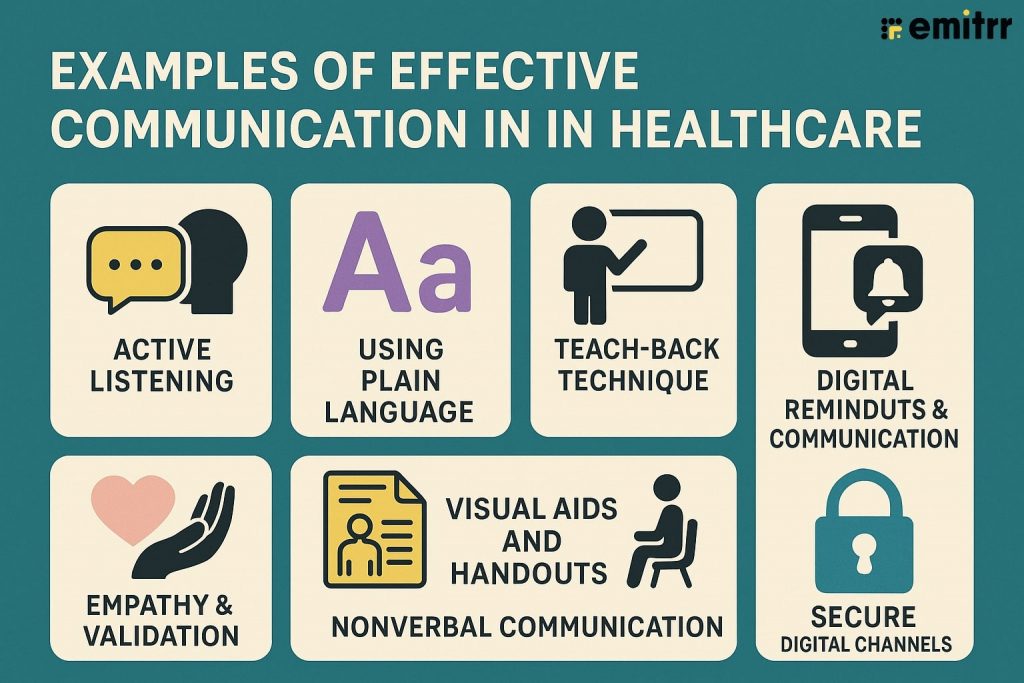
Active Listening
Example: A Nurse maintains eye contact with the patient, nods, and acknowledge the patient’s concern:
“So what I’m hearing is that the pain gets worse in the evenings—is that right?”
This ensures the patient feels heard and clarifies the issue.
Using Plain Language
Example: Instead of saying “You’ll need to take this antibiotic BID for 7 days,” the doctor says:
“Take this antibiotic twice a day—once in the morning and once in the evening—for 7 days.”
Nonverbal Communication
Example: A clinician sits at eye level with the patient, keeps an open posture, and does not cross their arms, signaling openness and respect.
Teach-Back Technique
Example: After explaining how to use an inhaler, the clinician asks:
“Can you show me how you’ll use this inhaler when you’re at home?”
This verifies understanding.
Empathy & Validation
Example: A physician says:
“I can see that this has been very stressful for you. It’s understandable to feel overwhelmed.”
While talking to patients, this builds rapport and trust.
Digital Reminders & Communication with Patients
Example: A clinic sends an SMS reminder for appointments and medication refills, reducing no-shows and improving adherence.
Visual Aids and Handouts
Example: A nurse uses diagrams to explain post-surgery wound care and provides a printed guide that the patient can take home.
Factors Influencing Patient Communication in Healthcare
If you’re a healthcare provider, you would completely agree that doctor-patient conversation is the cornerstone of patient communication and experience. In addition to the myriad benefits that it entails, various factors influence provider-patient communication.
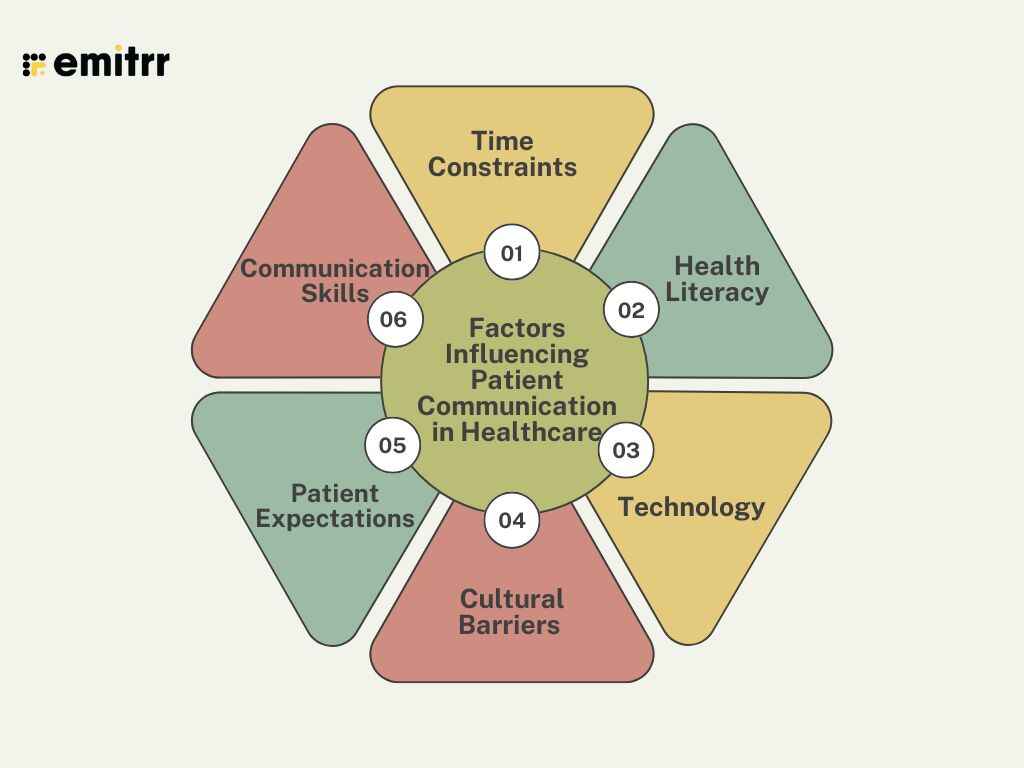
Several factors affect physician and patient communication, and hence cannot be ignored. These are:
Time Constraints
Since doctors treat multiple patients daily, they can only spend limited time with each patient. This means that the patient might be unable to put forth their questions and concerns fully.
Health Literacy
Since patients have varying health literacy levels, they might not be able to understand medical terminologies and might face difficulty expressing their concerns effectively.
Technology
The constantly evolving technology and its use in healthcare in the form of Telemedicine and Electronic Health Records (EHR) has become increasingly popular. This can affect doctor-patient communication.
Cultural Barriers
Both doctors and patients might hail from different cultural backgrounds which can make communication difficult.
Patient Expectations
The patient may have high expectations of the doctor and might expect personalized care. Any mismatch can lead to frustration and distress for the patient.
Communication Skills
Both the doctor and patient can have different levels of communication, which might act as a barrier to helping them convey concerns and provide solutions effectively.
Channels For Doctor-Patient Communication
There are several channels for facilitating communication between doctors and patients.
- Text messaging
- Social media
- Patient portals
- Phones
- Emails
- Patient forms
Let’s go through each of these in detail.
Text Messaging
When it comes to effective doctor patient communication skills, texting can be a useful channel due to the following reasons:
- Patients can communicate with their doctors from anywhere, thereby the need for conversing through phones or in-person visits. This instant communication works best in the case of urgency.
- Texting is a better way to communicate for patients who have speech or hearing impairments or cannot commute long distances due to mobility issues.
- Texting is a great way for two-way communication between providers and patients, whether it is scheduling appointments, sending out medication reminders, or seeking any advice.
- Texting gives a written record for conversations which avoids miscommunication and also enhances continuity of care.
As a provider, if you’re talking to patients, make sure that you’re using a secure medical texting platform.
Patient Portals
Though patient portals are a secure channel for sharing medical information, they aren’t something that patients are inclined towards to communicate with doctors. Here are reasons why patient portals are slowly failing as a means of effective doctor patient communication.
- 70% of the patients prefer directly speaking with the doctor, instead of going through the trouble of signing up in the patient portal
- Old customers, who are not technologically inclined, cannot use patient portals. For them, logging into a computer, adding signup details, and remembering those details is simply too much work. If they want to book an appointment, would they not prefer calling or texting the practice instead? The ease of use of patient portals is questionable when it comes to older patients.
- Even if the provider uses a patient portal, it is not necessary that the patient will also use it.
Interesting fact:
Did you know that over 90% of doctors provide patients access to patient portals but only 30% of patients use it?
The challenge in using patient portals is that the patient has to access their health records and communicate with the doctor. When the end goal is patient satisfaction, why not use something convenient, accessible, familiar, and time-saving?
This is when texting comes into the picture. If a patient has to book an appointment or has to share some specific concerns, they can simply pick up their phone and send a text message. They need not log in to their patient portals to communicate details now and then. They need secure and convenient messaging that serves their needs. To make communication with your patients easier, you can sign up for a texting app that overcomes all challenges that arise with patient portals.
To sum up, here are some differences between patient portals and texting apps.
| BASIS OF DIFFERENCE | PATIENT PORTALS | TEXT MESSAGING PLATFORM |
| Security | A secure platform to share and store patient information | Needs to be HIPAA-compliant |
| Ease of communication | Difficult to communicate | Easy communication |
| Ease of use | Difficult to use, especially for non-tech-savvy people | Easy to use for everyone |
| Use cases | Receiving lab results Renew prescription medications Access medical records | Automated reminders Group texting Surveys Patient recall Digital patient intake |
| Login | Extensive login | Minimal and easy login |
Phones
Phones serve a lot of functions and have been a constant in the lives of individuals and businesses alike. Phones work best for personal, detailed, and real-time communication. However, there are a lot of disadvantages associated with phones that make it the less preferred choice, when compared with texting.
With phones, you can communicate with only one person at a time. In the case of text messaging, you can manage multiple conversations simultaneously. Texting is more time-saving in nature.
The reason why doctors are shifting to texting is that they want to reduce the high call volume and move those conversations to text which don’t require calling. For instance, if a patient wants to book, confirm, or reschedule an appointment, they can communicate with their doctors via text, instead of calling them.
If they stick to calling, they can experience disruptions such as poor call quality and background noise, and even might not be able to get in touch with their provider right away. With text messaging, they can communicate with their provider at their convenience.
In comparison to calling, text messaging proves to be a better option for both the provider and the patient.
| BASIS OF DIFFERENCE | PHONES | TEXT MESSAGING PLATFORM |
| Managing communications | Can communicate with one patient at a time | Can manage multiple conversations at a time |
| Ease of communication | Difficult to communicate in case of disruptions | Easy communication |
| Ease of use | Good for detailed conversations | Good for instant communication |
| Availability | Calls can get missed | All messages can be responded to |
| Compliance | Not HIPAA compliant | HIPAA-Compliant (depends on platform) |
Emails
Emails work well if you have to communicate in detail, send attachments, or archive conversations. However, you cannot send sensitive patient health information over email as Email is also NOT HIPAA-compliant. In addition, emails can go to spam, get lost in the crowded inbox, and are subject to security breaches. Hence, as a provider, you must sign up with a patient communication platform that is compliant with HIPAA. Pick a platform that offers a high level of encryption and centralized control.
In addition to using an encrypted email service, make sure that you obtain the consent of the patient. Also, make sure to encrypt all attachments, and send a secure subject line.
| BASIS OF DIFFERENCE | TEXT MESSAGING PLATFORM | |
| Response rate | 10% | 45% |
| Ease of communication | Difficulty to communicate due to low response rate | Easy communication |
| Ease of use | Good for detailed conversations | Good for instant communication |
| Connectivity | Need internet connectivity | Can communicate anywhere, anytime with cell phone reception |
| Compliance | Not HIPAA compliant | HIPAA-Compliant (depends on platform) |
As a provider, you must assume that your patient s not aware of the risks associated with receiving personal health information via email. Hence, you must alert the customer about the potential risks involved while sharing personal information. If they agree, then it is permissible to send the PHI with them. In addition, you must also look for alternate ways to send such information, such as a text messaging platform like Emitrr.
If you still want to use emails, make sure to use a cloud-based email server that is HIPAA compliant. Another way is to encrypt the message you wish to send via email.
Patient Forms
Patient forms are another great channel for effective doctor patient conversation, as not only do they help in acquiring accurate information and saving time, but it is also a way for the patient to share their health concerns privately.
If a patient has to share some important yet sensitive information but isn’t comfortable communicating the same verbally to the doctor, they can simply mention it in the form given to them. With this approach not only will the information be shared but the patient will also not feel uncomfortable.
Emitrr has 1000+ free online form templates that you can easily customize, download, and share with your patients.
Social Media
While social media chat tools like Webchat and Facebook chat are great for generic information sharing, real-time communication, exchanging common questions, and engaging with patients, it is not secure for sharing personal health information. Though it can be used for patient communication, both parties would need to switch to a secure platform to exchange sensitive information.
All in all, out of all the channels texting reigns supreme as it is more immediate and familiar, and is easy to use. It is the best channel to facilitate seamless communication between doctors and patients.
As a provider, you need to make sure that you don’t share sensitive information through simple SMS, but use a secure texting platform that is HIPAA-compliant.
Benefits Of Physician And Patient Communication Via Text
Did you know that 90% of patients find texting to be an ideal way to connect with doctors? Here are the benefits that both doctors and patients can enjoy through text:
- Patients and doctors can reach out to each other easily
- Timely communication between doctors and patients, especially during follow-up care
- Gives patients an easy way to be informed about their health
- Easy booking cancellation, confirmation, and rescheduling of appointments
- Reduced wait times and improved patient experience
- Efficiency pertaining to the provision of healthcare services
- Reduced high call volume as information can be communicated via text
Risks Of Doctor Texting Communication
Though texting is convenient, fast, and efficient for patient communication, it has its risks such as:
- No end-to-end encryption, which means data can be intercepted in transit
- No recipient verification, which means the information can be sent to the wrong person
- Messages can be easily deleted
- Messages can remain indefinitely, which creates a privacy risk in case the device gets stolen
- The messages containing sensitive PHI can be easily viewed by unauthorized individuals
These risks can be eliminated by having a text messaging app in place that is HIPAA compliant. Before we dive deeper into the same, let’s first discuss why texting is better than other channels of provider-patient communication.

HIPAA-Compliant Doctor Texting
Considering that doctor patient communication through text is subject to privacy breaches, providers need to ensure that they take security and privacy into account while communicating with patients. This is where secure texting comes into the picture.
While doctors can communicate with patients via text, they need to satisfy certain requirements which can be taken care of by text messaging platforms. There are a lot of regulations in place that providers need to follow.
Text messaging platforms operate in compliance with HIPAA regulations, which means that they are HIPAA-compliant. With HIPAA-compliant messaging apps, you can:
- Make secure voice/video calls
- Have remote collaborations in secure environments
- Share secure PHI
- In the case of EMR integrations, send information directly from the app to the EMR
All sensitive communication is saved in a private cloud. Here are some things that text messaging platforms do to ensure safe and effective doctor-patient communication:
- Implementing safeguards to ensure the integrity, confidentiality, and availability of ePHI.
- Placing controls to prevent the use of ePHI by unauthorized individuals. This is done by encrypting data at both rest and transit levels.
- Maintaining an audit trail
- Monitoring and tracking the activity of authorized individuals
- Preventing the tampering of messages
- Preventing unauthorized access in case of theft
Standard messaging doesn’t have any such controls. Hence, it is high time that you adopt secure text messaging platforms to enhance productivity, improve the quality of care, achieve shorter wait times, and improve patient throughput.
Message Securely With Emitrr’s Secure Texting Feature
Text messaging by default is NOT HIPAA Compliant and hence is not secure for sharing personal health information. As a provider, you must sign up with a dedicated texting service that offers HIPAA-Compliant texting. With HIPAA compliant texting platform, you can easily store and manage patient health information. Emitrr’s texting complies with HIPAA regulations and offers a unique feature called ‘Secure Texting’.
In this type of texting, you can easily share personal health information with your patients that they can access on a secure portal through a simple login process.
Here’s how this works:
Right now in this chat, it clearly states that the chat is sent via SMS and it is hence not recommended to exchange PHI through the same. To share and receive PHI, there’s an option to ‘Start Secure Chat’.

Once you click on Start Secure Chat, your messages will be sent through a secure link. When you send a message to your patient, they’ll receive a text that says they’ve received a secure message from you, and they will need to click on the link provided in the text to continue the conversation.
Once they click on the link, all the remaining personal conversations will be done on that secure portal. To log in to that secure portal, your patients just need to click on the link, enter their mobile number, and enter the One time Password (OTP) received on that number. That’s it! No need to fret over extensive logins, and no need to remember passwords.

Here’s a video showing how you can send secure texts to patients using Emitrr Software:
Top Strategies For Effective Doctor-Patient Communication
If you’re a healthcare provider, these simple strategies can help you connect with your patients effectively:
- Use simple language while talking to patients
- Acknowledge your patient’s medical state and make them feel comfortable
- Use visual aids like illustrations, diagrams, photos, and videos
- Treat your patients with dignity and respect, irrespective of their age, gender, social status, or cultural background.
- Encourage your patient to ask questions
- Be an active listener
- Always remember to follow up during the appointment and treatment process
- Incorporate panel management to build better relationships
- Share sensitive information yourself
- Know your patient beforehand
Learn How to Use SMS for Doctor and Patient Communication?
Best Practices For Doctor-Patient Communication Via Text
To make the most out of your communication with your patients, here are some best practices that you must keep in mind:
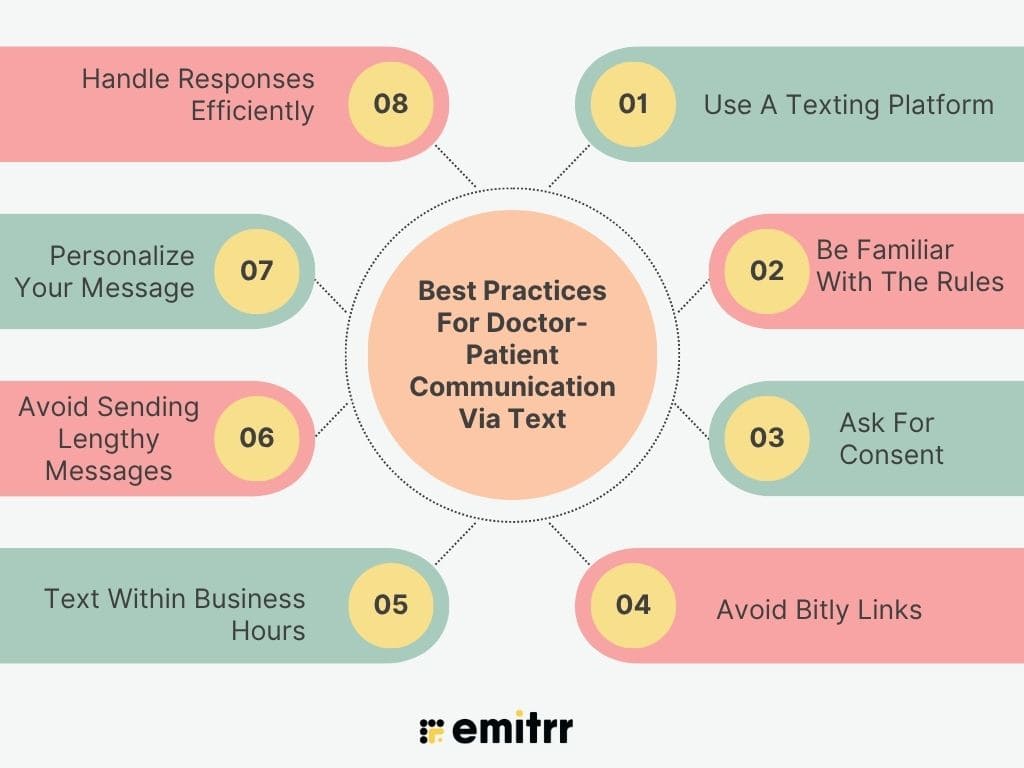
Use A Texting Platform
To ensure seamless and secure texting with your customers, make sure that you sign up for a text messaging platform that is HIPAA-compliant and allows you to easily exchange PHI. Using a HIPAA-compliant platform will ensure the protection of patient information, and will keep you away from any potential fines or legal troubles. Emitrr, for example, is a HIPAA-compliant texting platform that allows you to text securely with your patients. Learn more about secure texting later in the article.
Be Familiar With The Rules
As a healthcare provider, you need to be upfront with all the rules that govern texting with patients. Some laws that you must know about are TCPA and HIPAA Privacy Rules. TCPA revolves around patient consent by allowing easy opt-ins and opt-outs. HIPAA Privacy Rule limits the way patient information can be accessed or shared.
Ask For Consent
Asking for the patient’s consent is something that you need to practice while sending their information to other parties. Also, for texting, you must ask them if they’d like to receive communications from you. You can send an opt-in request and also include the option to opt out.
Avoid Bitly Links
Bitly links are the elements that make a text message look spammy and they often don’t get delivered to the patients. Make sure to not use Bitly if you want to shorten links. You can use Emitrr’s link-shortening feature for the same. Doing so will improve your delivery rates by ensuring that your messages aren’t going to spam.
Text Within Business Hours
You must follow certain texting etiquette while communicating with your patients. Make sure to not send messages very early in the morning or late at night. Try texting between business hours, as that is when people are the most active and you’ll get the most responses. Texting at odd times can make your patient frustrated and might affect communication. Also, make sure to inform them that they can reply to the message that you’re sending.
Avoid Sending Lengthy Messages
Typing out lengthy messages is not something that will get you instant responses. Make sure the messages are crisp and to the point that not just convey the information but also stay within the character limit.
Personalize Your Message
Send personalized messages to your customers to make them feel valued. Simple things like giving them special offers, wishing them on their birthday, and addressing their concerns can help you connect effectively with your patients. Also, introduce yourself so that the patient knows who’s texting them. This will build trust between you and your patient.
Handle Responses Efficiently
When you send text messages to your patients, also think about the way you would be responding when they text you back. Consider how you’ll be responding, how much time it will take for you to respond, if you’re not available how you’ll set up auto-responders, and how you’ll handle complex queries.
With all the aforementioned best practices, you can improve provider-patient communication by leaps and bounds, and ensure higher satisfaction not just on the part of your patients but for your staff as well.
Dont’s Of Doctor-Patient Communication
Here are some dont’s that you must keep in mind while texting with your patients:
- Don’t send too many emojis or acronyms
- Don’t force the patient to text you back
- Don’t share any information without the patient’s consent
- Don’t use complex medical terms
Frequently Asked Questions
Doctor-patient communication is important so that the patient is well informed and involved in the decisions related to his/her treatment. Ensuring a comfortable atmosphere, good care, sharing knowledge, etc. are all aspects of good doctor patient communication.
The doctor should focus on asking patient concerns and not just questions that are needed by them. For this, they should ask open-ended questions that require the patient to reveal more details.
Poor doctor-patient communication leads to less adherence to treatment, inefficient use of resources, and increased levels of patient dissatisfaction.
You can use a patient communication tool like Emitrr to effectively communicate with patients. Emitrr offers omnichannel and HIPAA-compliant communication channels for doctors so that they are able to text their patients with confidence.
Conciseness, clarity, correctness, completeness, and courtesy are the 5 C’s of effective communication. By sticking to these five principles, you can always ensure that your messages are understood and received clearly.
Conclusion
Effective physician and patient communication is an essential part of delivering high-quality care and patient satisfaction. Text messaging is a valuable tool for doctor-patient communication as it helps in enhancing the delivery of healthcare services, while also improving patient engagement, satisfaction, and outcomes.
Did you know that 81% of patients prefer getting appointment reminders and confirmations via text? Therefore, as a healthcare provider, it is essential that you harness the potential of texting and communicate efficiently with your patients.
In an era where texting is becoming the dominant mode of communication, ensure that you stay up-to-date and don’t get left behind!

 4.9 (400+
reviews)
4.9 (400+
reviews)
